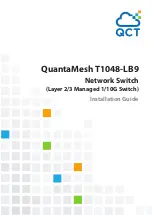
163
Step
Command
Remarks
3.
Specify the area
authentication mode and
key.
area-authentication-mode
{ {
gca
key-id
{
hmac-sha-1
|
hmac-sha-224
|
hmac-sha-256
|
hmac-sha-384
|
hmac-sha-512
} [
nonstandard
] |
md5
|
simple
} {
cipher
|
plain
}
string
|
keychain
keychain-name
} [
ip
|
osi
]
By default, no area authentication
is configured.
4.
(Optional.) Configure the
interface not to check the
authentication
information in the
received Level-1
packets, including LSPs,
CSNPs, and PSNPs.
area-authentication send-only
When the authentication mode
and key are configured, the
interface checks the
authentication information in the
received packets by default.
Configuring routing domain authentication
Routing domain authentication prevents untrusted routing information from entering into a routing
domain. A router with the authentication configured encapsulates the key in the specified mode into
Level-2 packets (LSP, CSNP, and PSNP) and check the key in received Level-2 packets.
All the routers in the backbone must have the same authentication mode and key.
To prevent packet exchange failure in case of an authentication key change, configure IS-IS not to
check the authentication information in the received packets.
To configure routing domain authentication:
Step
Command
Remarks
1.
Enter system view.
system-view
N/A
2.
Enter IS-IS view.
isis
[
process-id
] [
vpn-instance
vpn-instance-name
]
N/A
3.
Specify the routing domain
authentication mode and
key.
domain-authentication-mode
{ {
gca
key-id
{
hmac-sha-1
|
hmac-sha-224
|
hmac-sha-256
|
hmac-sha-384
|
hmac-sha-512
}
[
nonstandard
] |
md5
|
simple
}
{
cipher
|
plain
}
string
|
keychain
keychain-name
} [
ip
|
osi
]
By default, no routing domain
authentication is configured.
4.
(Optional.) Configure the
interface not to check the
authentication information in
the received Level-2
packets, including LSPs,
CSNPs, and PSNPs.
domain-authentication
send-only
When the authentication mode
and key are configured, the
interface checks the
authentication information in the
received packets by default.
Configuring IS-IS GR
GR ensures forwarding continuity when a routing protocol restarts or an active/standby switchover
occurs.
Two routers are required to complete a GR process. The following are router roles in a GR process.
•
GR restarter
—Graceful restarting router. It must have GR capability.
•
GR helper
—A neighbor of the GR restarter. It assists the GR restarter to complete the GR
process. By default, the device acts as the GR helper.
Summary of Contents for HPE FlexNetwork 7500 series
Page 505: ...493 Connector N A ...
















































